The combination of cryptocurrency and AI is rapidly becoming one of the most inspiring design frontiers.
Author: Danny Sursock, Head of Archetype Fund
Translation: xiaozou, Golden Finance
1. Platform Transformation
The world is shaped by periods of significant change in technology or infrastructure, and when they undergo major shifts, they unleash generational functional innovations that shape a new world. Think of telegrams and railways, fiber optic cables and the internet, or mobile phones and 3G networks.
We believe that the convergence of artificial intelligence (AI) and blockchain, two pioneering fields, is a similar moment of transformation.
The three main theoretical pillars of this article are as follows:
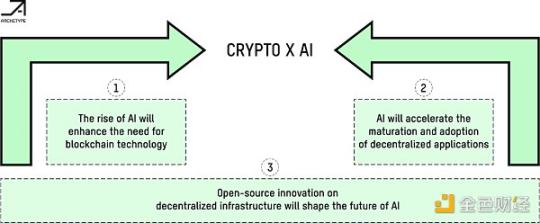
- The rise of AI will increase the demand for blockchain technology
- AI will accelerate the maturity and adoption of decentralized applications
- Open-source innovation in decentralized infrastructure will shape the future of AI
2. Blockchain Can Provide Better Design Space
Artificial intelligence has a significant impact in many areas, but can generally be categorized into three main types:
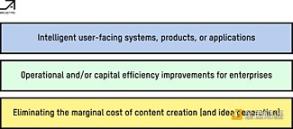
- User-facing intelligent systems, products, or applications
- Improving enterprise operations and/or capital efficiency
- Eliminating the marginal cost of content creation (and creative generation)
In particular, generative AI brings unique challenges and opportunities, and we believe that blockchain technology can leverage its advantages.
To understand the reasons behind this, it is important to consider the core inputs driving the evolution of intelligent systems. Machine learning (ML) is fundamentally driven by data (large amounts of data, but increasingly higher quality), feedback mechanisms, and computational power.
Major participants in the field of artificial intelligence/machine learning, such as OpenAI (backed by Microsoft) and Anthropic (backed by Google and Amazon), have already integrated resources and built barriers around their own models and data. However, despite early advantages in computation, data, and distribution, this approach may disrupt the collaborative development cycle that initially drove the industry and stifle momentum.
Blockchain, like Ethereum, provides a viable solution and has become a reliable neutral data and computational system, driving open-source innovation. Blockchain has supported a range of digital native primitives that are well-positioned to play a crucial role in a world increasingly shaped by generative AI.
We believe that blockchain has a significant opportunity to become a major force in open-source research and development in the field of artificial intelligence.

3. Current Market Situation
This year, significant investments have been made in core infrastructure, model layers, and even user-facing applications (such as chatbots, customer support, and coding assistants). However, in the long run, where value accumulates in traditional domains (and flows to whom) is not clear.
In the current paradigm, AI has the potential to become a centralized force, continuing to expand the dominance of web2 market leaders. Particularly in infrastructure and model layers, the game is one of expansion—expansion in terms of hardware and capital resources, data access, distribution channels, and unique partnerships.
From cloud service providers like AWS to hardware manufacturers like Nvidia and established giants like Microsoft, many participants are moving towards a full-stack model, whether through acquisitions or through patent collaborations.
The top giants are competing for scale and profits, but the market for super-expensive, high-precision enterprise API models may be constrained by economic, open-source performance convergence, and even low-latency workload demand trends.
At the same time, a large part of the mid-market has seen a trend towards commoditization of products similar to "OpenAI API wrapper," which are feature-rich but difficult to differentiate.
4. Momentum in Open Source Development
Open-source datasets for pre-training, training, and fine-tuning, as well as free access to basic models and tools, encourage businesses of all sizes to directly leverage open-source systems and tools to unleash their creativity.
An article leaked by Google outlines the rapidly shrinking gap between closed-source and open-source code worlds. It is worth noting that today, 96% of code repositories use open-source software, a trend particularly evident in the fields of big data, artificial intelligence, and machine learning.
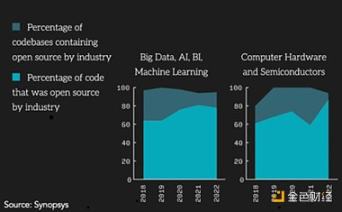
At the same time, the timing for disrupting the oligopoly of cloud services may have matured.
Historically, the big three—AWS, Google Cloud, and Azure—have entrenched their positions in the enterprise competition by layering tools and services. This dominance has brought many challenges to businesses, from restrictive operational dependencies to high costs related to cloud infrastructure, especially considering the premiums charged by major providers.
Existing companies are facing cost pressures for operational restructuring, and the attempt to integrate and utilize an increasing amount of open-source AI will create a window for businesses to restructure using decentralized alternative solutions.
Therefore, the emerging intersection of open-source AI and blockchain technology provides an extraordinary field for experimentation and investment.
5. Cryptocurrency and AI: Mutual Value Relationship
We are extremely excited about the potential symbiotic relationship between artificial intelligence and blockchain.
Cryptographic middleware can greatly improve the information input of AI suppliers by establishing effective computing and data markets (supply, labeling, or fine-tuning), as well as proof or privacy tools.
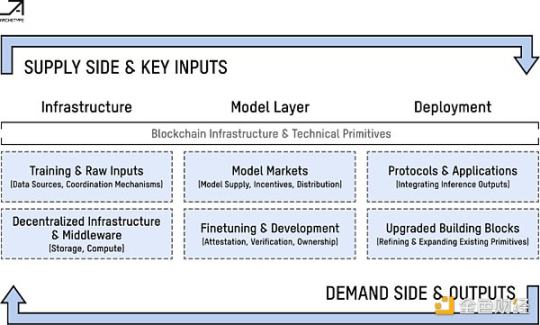
In turn, decentralized applications and protocols will reach new heights by absorbing the fruits of this labor.
Undeniably, cryptographic technology has made significant progress, but protocols and applications are still influenced by tools and user interfaces that are not intuitive for mainstream users. Similarly, smart contracts themselves may be limited, both in terms of manual workload requirements for developers and overall functional liquidity.
Web3 developers are a highly productive group. At its peak, just 75,000 full-time developers created an industry worth trillions of dollars. Coding assistants and ML-enhanced DevOps are expected to empower existing work, while no-code tools are rapidly empowering a new class of builders.
As machine learning capabilities are integrated into smart contracts and brought onto the chain, developers will be able to design smoother and more expressive user experiences, ultimately designing entirely new killer applications. This leap in on-chain experience functionality improvements will attract new—possibly more—audiences and catalyze an important adoption feedback loop.
Generative AI may be the missing link in cryptocurrency, changing UI/UX and ushering in a new wave of technological development. In turn, blockchain technology will leverage, generalize, and accelerate the potential of artificial intelligence.
6. Building Better Data Markets with Blockchain
(1) Data is the foundational information input for machine learning.
Yes, significant improvements in computational infrastructure are very useful, but it is massive databases like Common Crawl and The Pile that make it possible for foundational models to attract global attention today.
Furthermore, businesses will use this data to enhance the foundational models for their product offerings or build future competitive moats. Ultimately, data will bridge the gap between user and personal models that run locally and continuously adapt to individual needs.
Therefore, data competition is an essential frontier, and blockchain can gain an advantage in this area—especially when quality becomes an important attribute shaping the data market.
(2) Quality Over Quantity
Early research indicates that as much as 90% of online content in the coming years may be artificially synthesized. While synthetic training data has certain advantages, it also introduces significant risks related to model quality degradation and bias reinforcement.
In the coming years, machine learning models may exhaust non-synthetic data sources, which is a real risk. The coordination mechanisms and proof primitives of cryptocurrency are fundamentally designed to support decentralized market optimization, allowing users to share, own, or monetize their data used for training or fine-tuning models in specific domains.
Therefore, web3 may be a better and more efficient source for generating training and fine-tuning data.
(3) Progress
Blockchain-supported decentralized training, fine-tuning, and inference processes can also better preserve and utilize open-source intelligence.
Smaller open-source models have already begun to shift from quantity to quality in terms of sourcing and fine-tuning data, and have improved in output accuracy, comparable to larger models. The ability to track and verify the lifecycle of original and derived data can promote reproducibility and transparency, driving higher-quality models and inputs.
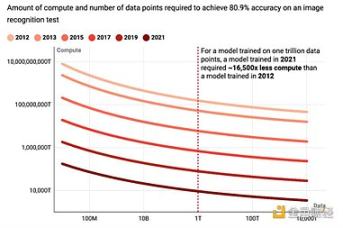
Blockchain can establish a persistent moat, becoming a primary domain for diverse, verifiable, and tailored datasets. This is particularly valuable in the face of traditional solutions over-indexing algorithmic progress to cope with data scarcity.
(4) Content Tsunami
The upcoming wave of AI-generated content is another area where the first-mover advantage of cryptocurrency will come into play.
This new technological paradigm will empower digital content creators at an unprecedented scale, and Web3's plug-and-play infrastructure makes everything simple and clear. Cryptocurrency has a home advantage, thanks to the development over the years of primitives around establishing ownership and immutable provenance of digital assets and content in the form of NFTs.
NFTs can capture the entire content creation lifecycle, but they can also represent digital native identities, virtual assets, and even cash flows.
Therefore, NFTs make it possible for new user experiences in the digital asset market (such as OpenSea, Blur), while also rethinking business models in written content (Mirror), social media (Farcaster, Lens), gaming (Dapper Labs, Immutable), and even financial infrastructure (Upshot, NFTFi).
This technology can even be more reliable in combating deep fakes and computational manipulation than another choice—using algorithms. A clear example is OpenAI's detection tool being shut down due to accuracy failures.
One last point: advances in concise and verifiable computation will also upgrade the dynamic landscape of NFTs, as they contain ML outputs to drive more intelligent, evolving metadata. We believe that AI tools and interfaces based on blockchain technology will unleash comprehensive value and reshape the digital content landscape.
7. Utilizing Zero-Knowledge Proofs for Infinite Knowledge in Machine Learning
The blockchain industry is seeking technical solutions to achieve resource-efficient computation while maintaining a trustless dynamic, and this has led to significant progress in zero-knowledge (ZK) proofs.
While the initial design was to address inherent resource bottlenecks in systems like the Ethereum Virtual Machine (EVM), ZK proofs provide a range of valuable use cases related to artificial intelligence.
A clear example is a simple extension of existing use cases: efficiently and concisely verifying computationally intensive processes, such as running ML models off-chain, so that the end product (such as model inferences) can be integrated on-chain in the form of ZK proofs through smart contracts.
Combining storage proofs with collaborative processing can further enhance on-chain applications to be more flexible and agile without introducing new trust assumptions, greatly enhancing their functionality.
Finally, ZKP has real applicability in the increasingly relevant (and challenging) field of distinguishing between artificial data and the synthetic data discussed earlier.
Some of these use cases depend on further development around the technical implementation and finding sustainable scalable economies, but zkML has the potential to have a unique impact on the trajectory of artificial intelligence development.
8. Long-Tail Assets and Potential Value
Cryptocurrency has proven its role as an outstanding architect of value flows in traditional markets such as music and art. In recent years, there have also been liquidity markets representing off-chain tangible assets (such as wine and sneakers).
The successors will naturally involve advanced ML capabilities, as artificial intelligence is brought on-chain and accessible by smart contracts.
ML models combined with blockchain rails will redesign the collateral processes behind illiquid assets that were previously inaccessible due to lack of data or buyer depth.
One approach is for machine learning algorithms to query a large number of variables to assess hidden relationships and minimize the attack surface for manipulators. Web3 has been attempting to create markets around new concepts such as social media relationships and wallet usernames.
Similar to the impact of AMMs on releasing liquidity for long-tail tokens, ML will fundamentally change price discovery by gaining implicit patterns through acquiring large quantitative and qualitative data. These new insights can form the basis of smart contract-based markets.
The analytical capabilities of artificial intelligence will be embedded in decentralized financial infrastructure to discover potential value in long-tail assets.
9. Decentralized Infrastructure Layer
Cryptocurrency has addressed one aspect of attracting and monetizing high-quality data, while the other aspect—the infrastructure support behind artificial intelligence—also has similar prospects.
Decentralized physical infrastructure networks (DePINs) like Filecoin or Arweave have already established systems for storage that inherently include blockchain technology.
Other companies like Gensyn and Together are addressing the challenges of distributed network model training, while Akash has introduced an impressive P2P marketplace that connects supply and demand for surplus computing resources.
Furthermore, Ritual is laying the foundation for open-source AI infrastructure in the form of incentive networks and model suites, connecting distributed computing devices for users to perform inferences and fine-tuning.
It is crucial to test different parts of the technology stack at scale (especially in the emerging fields of decentralized model training and computation), as they involve different constraints and value preferences.
However, the foundation for blockchain-based computing, storage, and even model training solutions already exists, and these solutions can ultimately compete with traditional markets.
10. Conclusion
The combination of cryptocurrency and AI is rapidly becoming one of the most inspiring design frontiers. It has already had impacts across various domains, from content creation and cultural expression to enterprise workflows and financial infrastructure.
In conclusion, we believe that these technologies will reshape the world in the coming decades. The best teams will integrate permissionless infrastructure, cryptoeconomics, and artificial intelligence to enhance product/service performance, achieve new behaviors, or realize competitive cost structures.
Cryptocurrency has introduced unprecedented scale, depth, and standardized data granularity to collaborative networks, and there is often no clear method to derive utility from this data.
At the same time, artificial intelligence transforms pools of information into vectors of relevant context or relationships.
When these two fields are combined, a unique symbiotic relationship can form, laying the foundation for decentralized builders of the future.
免责声明:本文章仅代表作者个人观点,不代表本平台的立场和观点。本文章仅供信息分享,不构成对任何人的任何投资建议。用户与作者之间的任何争议,与本平台无关。如网页中刊载的文章或图片涉及侵权,请提供相关的权利证明和身份证明发送邮件到support@aicoin.com,本平台相关工作人员将会进行核查。




